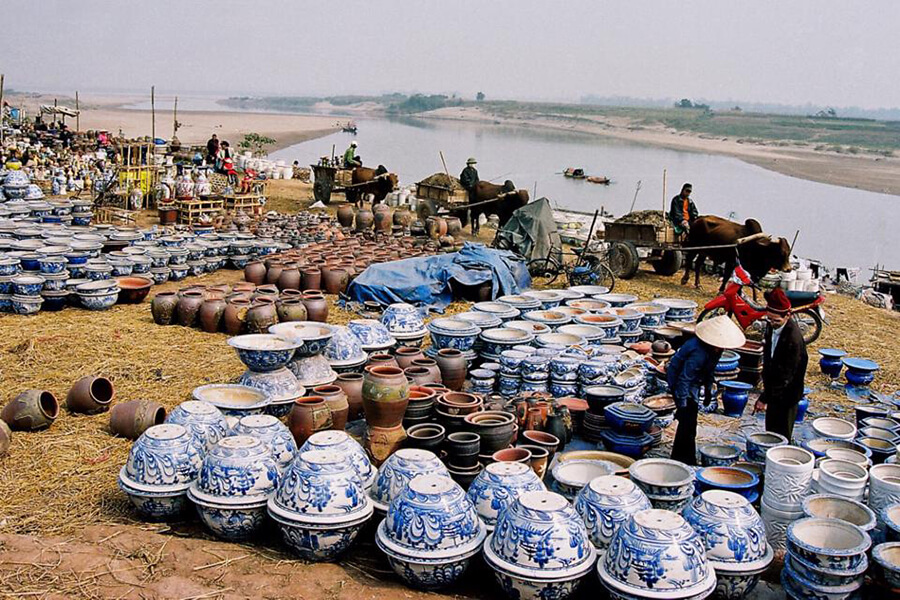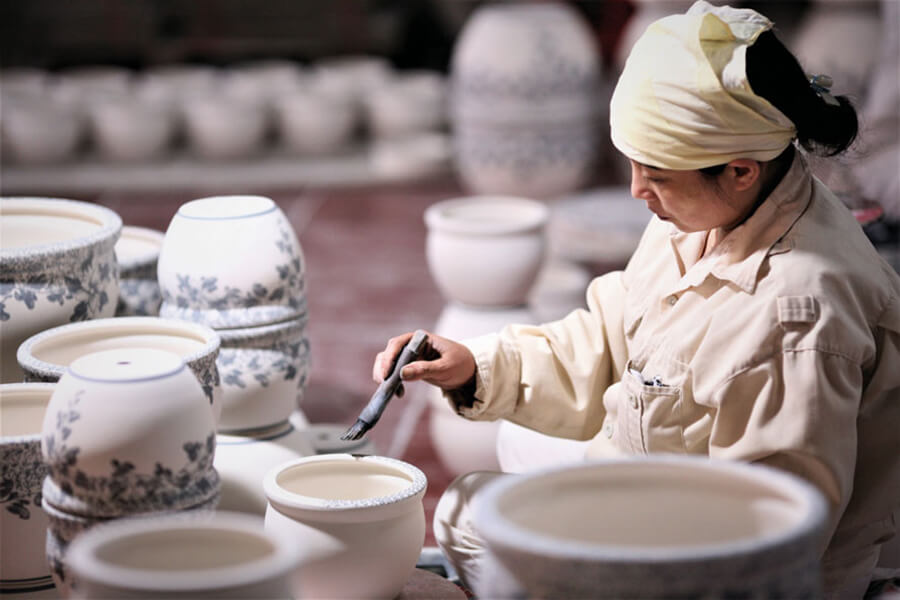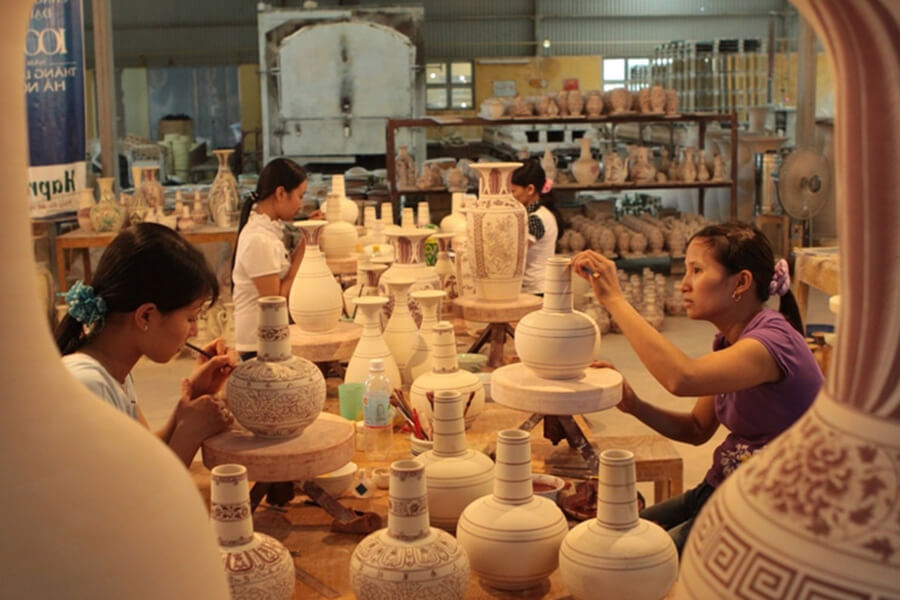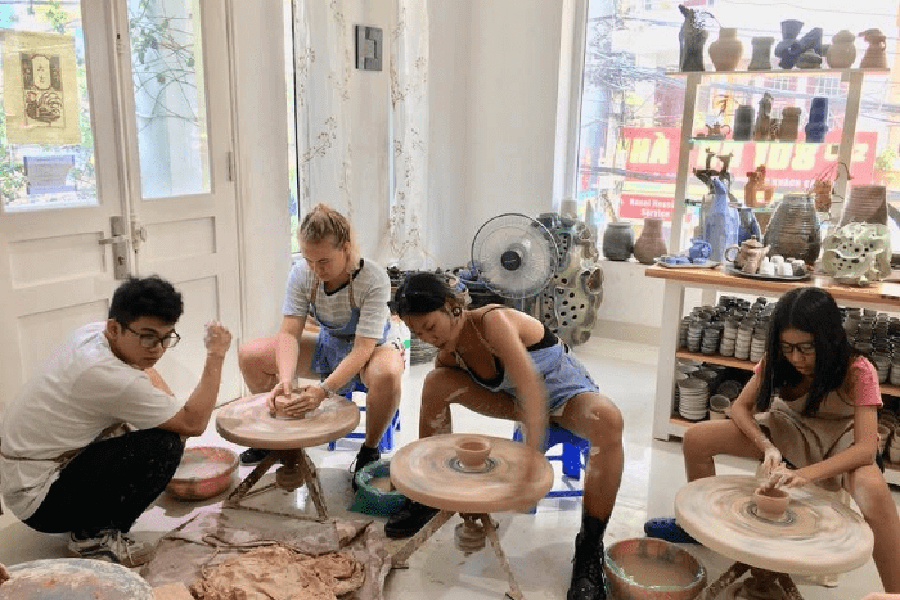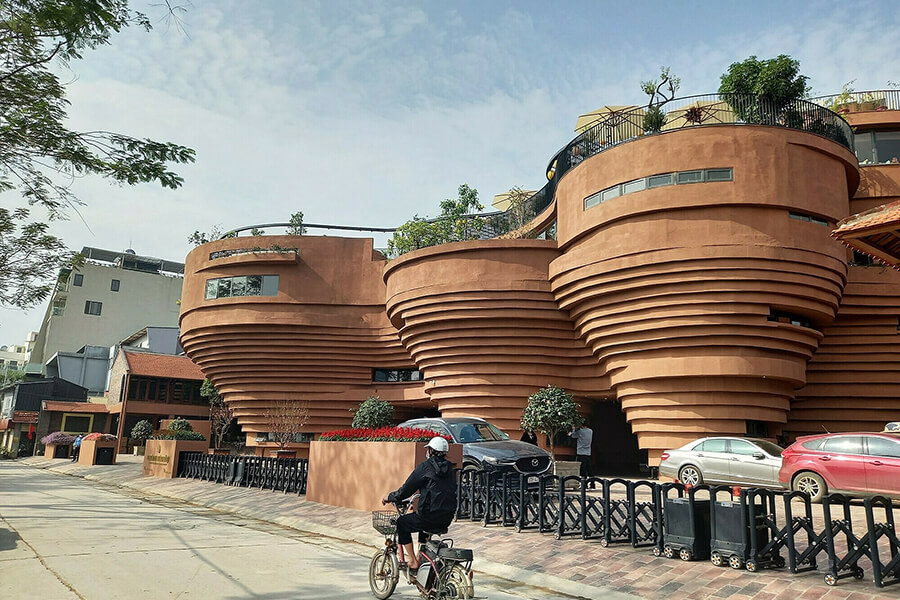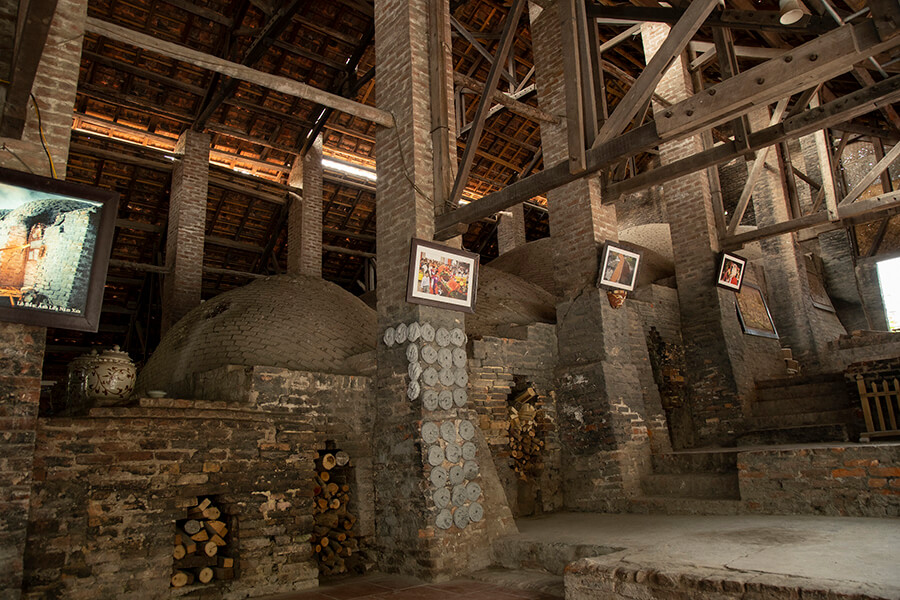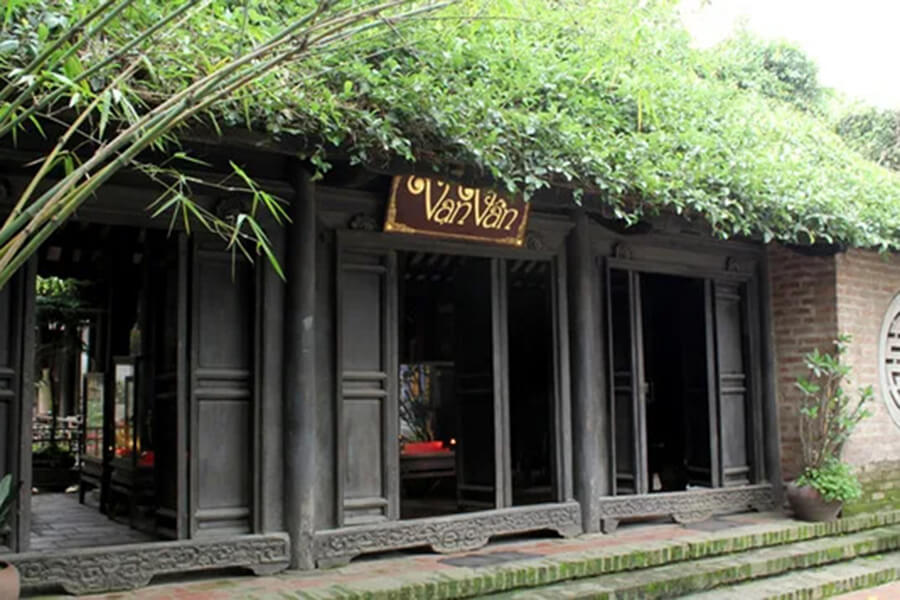When mentioning the traditional beauty of Hanoi, we not only think of the ancient Hanoi with its 36 streets and guilds but also extend our exploration to the suburban areas, specifically to the renowned "Ceramic and Pottery Art Museum" – the Bat Trang Ceramic Village. It is a well-known and ancient traditional craft village in Vietnam. This article will help you discover many interesting aspects of this place, so let's explore it together with Myhanoitours!
Overview of Bat Trang Ceramic Village
Bat Trang Ceramic Village is considered a vibrant living art museum, encapsulating the profound spiritual value and pride of the people of Hanoi and Vietnam as a whole. Visiting this village, you not only have the opportunity to observe, learn, and witness the process of creating a complete ceramic product but also explore tourist attractions and unique architectural structures. Additionally, you can hear locals share historical stories, express their thoughts about the pottery profession, and participate in traditional local festivals.
Location of Bat Trang Ceramic Village
Address: Hamlet 3 – Bat Trang Commune – Gia Lam District – Hamlet 7 – Dong Du – Gia Lam – Hanoi.
Situated approximately 15km southeast of Hanoi's city center, Bat Trang Ceramic Village, also known as Bat Trang Pottery Village, is located in the villages of Bat Trang and Giang Cao within Bat Trang Commune. This traditional craft village is situated in the lowland region along the Red River.
History of Bat Trang Ceramic Village
According to two historical documents in Vietnam, "Dai Viet Su Ky Toan Thu" and "Du Dia Chi" by Nguyen Trai, Bat Trang Ceramic Village in Hanoi has its origins traced back to five renowned pottery-making lineages in Yen Mo district, Truong Yen province (now Yen Mo district, Ninh Binh province).
In the year 1010, King Ly Thai To relocated the capital from Hoa Lu to Thang Long (present-day Hanoi). Recognizing the economic potential and the opportunity for development in this area, many traders and craftsmen chose this land to establish their livelihoods.
The most prosperous period for Bat Trang Ceramic Village was during the 15th to 18th centuries when Western countries expanded their presence in Asia, contributing to the flourishing of trade and commerce.
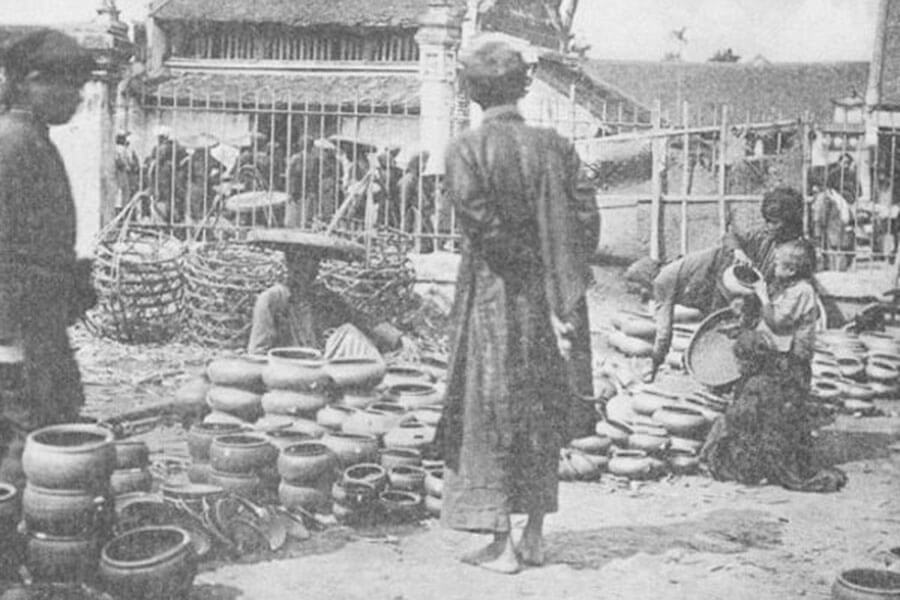 In the 18th to 19th centuries, the pottery trade faced a setback due to the Trinh Nguyen Lords' policies restricting foreign trade with other countries.
In the 18th to 19th centuries, the pottery trade faced a setback due to the Trinh Nguyen Lords' policies restricting foreign trade with other countries.
Today, Bat Trang Ceramic Village has experienced remarkable development in both product quality and scale, transitioning from cooperatives to specialized business companies and renowned family-owned pottery producers.
Despite integration and growth, the beauty of traditional ceramic art is still preserved in Bat Trang, serving as evidence for the saying, "Integration without dissolution."
The Fascinating Wonders of Bat Trang Ceramic Village
"Infiltrate" the Ancient Pottery Village in Bat Trang
The ancient Bat Trang Ceramic Village boasts a history of approximately 700 years, featuring narrow alleys winding around the village. Crafted from walls weathered by time and adorned with vibrant green moss, the village exudes a nostalgic charm. These unique "materials" will add a distinctive touch to your photographs, capturing the essence of this historic pottery village.
Furthermore, this place is also a conservation site for ancient houses, preserving the traditional way of life of the people of Bat Trang. An exemplary illustration is the ancient house of the artist Manh Duc – the son of the writer Kim Lan, constructed using wood and designed in a style modeled after the royal residence of King Meo in Ha Giang.
Within the space of this house, there is a large skylight, and inside, there is a small stage for ca tru performances in the evening. The majority of the house's area is utilized as a showcase for Bat Trang ceramic products and the essence of ceramics from various regions.
Another notable example is the ancient house built in the 1980s, famously known as the "House without Doors." This house boasts simple yet captivating architecture and currently serves as a workspace for artists in Bat Trang. In the future, it is expected to be a venue for organizing artistic events.
Unleash Your Pottery Skills in Bat Trang Ceramic Village
In Bat Trang Ceramic Village, there is a dedicated pottery molding area for tourists seeking to engage in the pottery-making activities. The participation fee for pottery molding is quite affordable. Initially, you might feel a bit uncertain, but don't worry, as the pottery artisans here are very enthusiastic about guiding you through the process.
Once your creation is shaped, it will undergo firing and can be decorated with various patterns of your choice. You even have the option to glaze the product for extended preservation. So, let your creativity flow and enjoy this hands-on pottery experience!
Explore Bat Trang Ceramic Market
If you're looking to own some exquisite and unique ceramic products, you should visit the Bat Trang Ceramic Market. Here, you'll find a wide array of handcrafted items, art pieces, souvenirs, and household utensils made from Bat Trang ceramics. Compared to prices outside, the items here are much more affordable. So, take a stroll through the market and discover the perfect ceramic piece to bring home as a cherished souvenir.
Check-in at Bat Trang Ceramic Museum
Address: Thon 5 – Bat Trang Commune
The Bat Trang Ceramic Museum, also known as the Essence Center of the Vietnamese Craft Village, is a captivating destination for visitors due to its distinctive design. The museum features seven interconnected gigantic spirals that form a unique and visually appealing structure.
The materials used in the construction are closely tied to the ceramics village, incorporating Bat Trang clay and tiles to honor the beauty of the craft village. The architectural design boasts soft lines inspired by the pottery wheel, creating multi-faceted curved surfaces with textured patterns formed by various undulating waves. Don't miss the opportunity to check-in and capture the artistic essence of Bat Trang at this museum.
Explore the Last Remaining Ancient Kiln at Bat Trang Ceramic Village
There are currently five ancient kilns, with a history of nearly 100 years, making them the last surviving ancient kilns in Bat Trang Ceramic Village. These kilns were traditionally used for firing ceramics manually, but to avoid environmental pollution, the people of Bat Trang have adopted modern firing techniques.
Today, these kilns are preserved to serve the tourism activities of visitors. You can venture inside these ancient kilns, witnessing the layout and structure of the firing kilns. Inside, a layer of glaze is still present, a testament to the kilns' operation in firing ceramics over the past 100 years. It's a fascinating glimpse into the heritage and history of Bat Trang's ceramic craftsmanship.
Explore Vạn Vân Ancient House
Opening Hours: Daily from 8:00 AM to 5:30 PM
Vạn Vân Ancient House is an exceptionally unique architectural gem with an age of approximately 11 centuries. This house consists of three sections: the first section is a 200-year-old house brought from Thai Binh, the second section is a house acquired from Nam Dinh, and the third section is the existing part of the house.
Visit the Bát Tràng Village Temple
Facing the majestic Red River, the Bát Tràng Village Temple is a sacred place dedicated to Thành Hoàng, the village's guardian spirit, and serves as the venue for various activities and festivals in Bat Trang. It is highly recommended to visit during local festivals to fully appreciate the beauty and cultural richness of this significant place!
The Ceramic Production Process in Bát Tràng Village
Clay Preparation
Soil Selection
The foundation of crafting high-quality Bát Tràng ceramic products lies in the choice of clay. The region's renowned development as a pottery village is attributed to its rich deposits of white clay—a fine, plastic, and minimally soluble clay with a grayish-white color.
Clay Processing and Mixing
To eliminate impurities from the clay and tailor it to specific ceramic types, the extracted clay undergoes a traditional processing method known as clay refinement. This process takes place in a system of four basins at varying heights:
- First Basin: The highest basin is used for soaking the raw clay in water for 3-4 months to allow it to disintegrate. After breaking down the mixture, the finely dissolved clay is transferred to the second basin.
- Filter Basin: Through filtration, the clay settles at the bottom, while impurities float to the top and are removed.
- Drying Basin: The diluted mixture is moved to the drying basin, where artisans sun-dry it for three days.
- Fermentation Basin: The entire product from the drying basin is transferred to the fermentation basin, where a fermentation process eliminates harmful substances in the clay.
The clay processing stage involves several intricate steps, and beyond that, artisans also blend the clay with kaolin to meet the requirements for different ceramic items.
Shaping
In the past, manual techniques like "Vuốt ve, be chạnh" on a potter's wheel were employed to shape the products. Before molding, the clay had to be kneaded into a soft, pliable consistency, placed on the spinning wheel. Every aspect of the product, including depth, width, mouth shape, etc., was determined by the skilled hands of the artisan.
However, nowadays, fewer craftsmen use traditional methods for shaping. Instead, they employ plaster molds to meet the demand for mass production of items like bowls, plates, cups, etc.
Drying and Raw Product Finishing
After drying, the products must maintain their shape, avoiding cracks, and ensuring complete dryness. Traditional artisans would sun-dry the items on racks in a well-ventilated area. Nowadays, some families use drying kilns, gradually increasing the temperature to prevent rapid evaporation.
Once dried, the products undergo a final refinement, with artisans gently pressing details for symmetry, rounding, and adjusting. Excess material is removed, and touch-ups are made where necessary.
Ornamentation and Glazing Process
Painting Technique
The creative artistry in the heritage of Bát Tràng Pottery Village lies in the hand-painting phase, where intricate patterns are applied using brushes. It is during this stage that products exude a distinct "spirit." Common decorative techniques used by Bát Tràng artisans include needle carving, flowing glaze application, and colored enamel painting.
 Additionally, there are techniques such as decal transfer and painting on raw clay, although these are not traditional features of Bát Tràng pottery.
Additionally, there are techniques such as decal transfer and painting on raw clay, although these are not traditional features of Bát Tràng pottery.
Glaze Production and Application
Artisans in Bát Tràng employ ash glaze to apply directly or fire it first and then glaze onto completed raw products. This stage requires skilled craftsmanship to achieve a beautiful glaze layer.
Final Glaze Touch-ups
Before entering the kiln for the final firing, potters must touch up the products, applying additional glaze or cutting away excess glaze.
Firing Process
Various kilns, such as tunnel kilns, dragon kilns, step kilns, and box kilns, are commonly used. Wood, coal, or gas is used for firing, and the temperature is adjusted based on the type of kiln and ceramic being produced.
This firing stage is crucial, as it determines the final appearance and durability of the ceramic products. Different kilns and firing methods contribute to the unique characteristics of Bát Tràng ceramics, creating a diverse range of products with varying colors, textures, and finishes.
Unique Aspects of Each Product from Bát Tràng Pottery Village
The higher cost of a product from Bát Tràng Pottery Village is not arbitrary; it reflects the meticulous selection of raw materials and the elaborate production process. Beyond these factors, each Bát Tràng ceramic product brings joy to its owner, serving as a spiritual gift for the Vietnamese people.
To fully appreciate and effectively use Bát Tràng ceramics, a certain level of understanding is required—a practice known as "The Art of Playing with Bát Tràng Ceramics." This knowledge enhances the user's experience, connecting them more deeply with the cultural and artistic nuances embedded in each piece.
The product range from Bát Tràng Pottery Village is diverse in terms of designs and types. Some popular items that users particularly favor include Bát Tràng tea sets, ceremonial pottery, Bát Tràng vases, and aromatic oil lamps. Each of these items carries a unique charm and cultural significance, making them cherished possessions and meaningful gifts.

